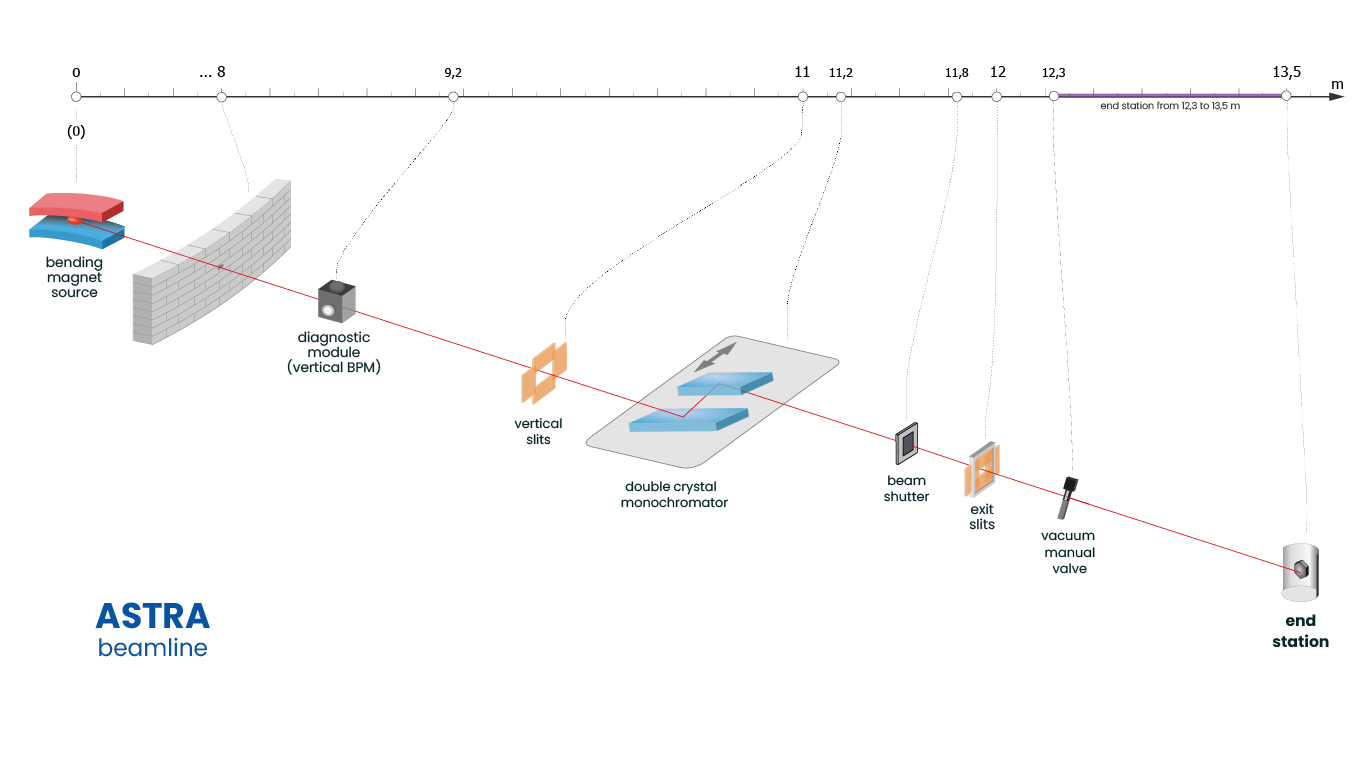The bending magnet beamline ASTRA (Absorption Spectroscopy beamline in Tender energy Range and Above) IS dedicated to X-ray absorption spectroscopy (XAS) and related techniques in the energy range from 1 keV to 15 keV, covering the K absorption edges of chemical elements between Mg and Se along with the L and M edges of many other elements. XAS is a non-destructive, element specific characterization method which can be applied to both crystalline and amorphous materials, liquids and samples in the gas phase. Moreover, XAS measurements can be performed under application relevant conditions (in situ). Both XANES (X-ray absorption near-edge structure) and EXAFS (extended X-ray absorption fine structure) data contain valuable structural information about the atomic environment of the absorber atoms in the materials under investigation. At ASTRA beamline XAS spectra can be recorded in transmission or fluorescence mode.
The ASTRA beamline is intended for fundamental and applied research in:
- materials science, physics and chemistry (investigation of functional materials, esp. alloys, oxidic systems and catalysts, coatings, adhesives, etc.)
- biomedicine (investigation of metalloproteins, investigation of the stability, uptake and therapeutic mechanism of action of inorganic and bio-inorganic drugs, etc.)
- environmental protection (e.g., speciation of toxic elements during bioaccumulation).
The ASTRA beamline was especially designed for XANES/EXAFS measurements in the tender X-ray range, i.e., at the K absorption edges of important elements such as P, S, Si, Al and Mg. Besides, ASTRA` energy range also includes K-edges of heavier elements up to Se, L-edges of elements up to Bi and some M-edges of elements including U, which allows investigation of a variety of highly relevant materials.
The beamline is built by the project leader Hochschule Niederrhein University of Applied Sciences (Germany) in collaboration with the Synchrotron Light Research Institute (Thailand), the Physics Institute of Bonn University and National Synchrotron Radiation Centre SOLARIS Jagiellonian University.
Beamline parameters:
Source: Bending magnet (1.31 T)
Target energy range: 1 – 15 keV
Available energy range: 1.8 – 12.0 keV
Energy resolution ΔE/E: InSb(111): 7 × 10-4 (at sulfur K edge – 2.472 keV) data for other crystals and for other edges will be completed in near future
Beam size at sample (max.) (H × V): 10 mm × 1 mm
Photon flux at sample: 109-1010 [ph/s/0.1 A]
Polaryzation: Linear (horizontal)
End station: ASTRA (X-ray absorption spectroscopy chamber):
Currently available
Research techniques: XANES/EXAFS
Detection methods: Transmission
Temperature conditions: Room temperature
Pressure: Low vacuum or atmospheric pressure
Gas conditions: Presence of the selected gases (He, Ar, O2, N2, CO2)
Under development (not available in current Call)
Research techniques: XRF, high-resolution X-ray emission spectroscopy
Detection methods: Fluorescence, Total Electron Yield
Temperature conditions: 5 - 1000 K
Pressure: High Vacuum, high pressure
Gas conditions: Controllable flow of gas of interest
- EXAFS
- NEXAFS
- Catalysis
- Physical Chemistry
- Geology
- Nanotechnology & production processes
- Arts
- Cultural Heritage
- Agriculture & Fisheries
- Food quality and safety
- Pharmaceutics (drug screening)
- Protein and macromolecular structures
- Metallurgy
- Other - Material Sciences
- Nanophysics & physics of confined matter
- Other - Physics
- Soft condensed matter physics
30-392 Krakow, Poland
- Custom-developed code written in LabView (Graphical user interface)
- 1D spectra
- ASCII files
- Demeter program
